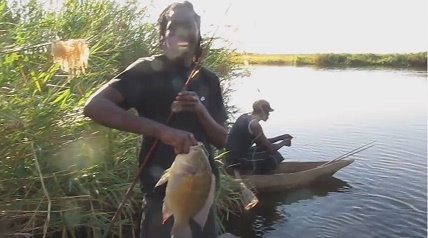Africa Galleries:
Lion Encounter/Victoria Falls, Zimbabwe
Elephants: Kruger National Park, Karongwe Private Game Reserve, Elephant Adventure, Crossing Zambezi River and Botswana's Chobe National Park
Some of the Safari Animals We Saw on Safari Outings
Some of the Safari Animals We Saw on Safari Outings Continued
A Potpourri of Eclectic Sights from South Africa, Zimbabwe and Botswana
Bill and I just returned from visiting South Africa, Zimbabwe and Botswana. We went mostly for the safari photo experience and, of course, cultural exchange. It was a really interesting trip. If you are thinking about taking this adventure-do it! While we were there we had the experience of eating a number of different dishes that included a variety of African game. Some of the game we had at restaurants. The City Grill/Capetown Waterfront was excellent. The game was so well prepared, plated and served. African fish such as bream which comes from the Zambezi River was superb. We also had game at the "Boma Dinners" which are festive evenings out in Africa. It should be noted that none of the game were endangered and much of what we tried is eaten by the local population. Below I will list some of the game that we tried.
About Boma Dinner
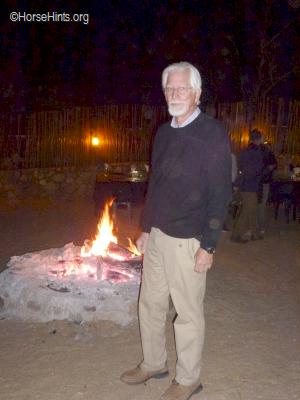 Bill and I enjoyed a "boma dinner" outside under the stars in South Africa, Limpopo Province. What is a boma dinner? "The traditional African starlit Boma is nestled within the surrounding bush, merely footsteps away from the lodge. ... Boma, meaning Kraal in Swahili, forms an enclosure, usually made from latte sticks, for camps and fortified villages during the 18th and 19th century, when tribal wars and colonial conquests were common." Usually for tourists there is also local entertainment.
Bill and I enjoyed a "boma dinner" outside under the stars in South Africa, Limpopo Province. What is a boma dinner? "The traditional African starlit Boma is nestled within the surrounding bush, merely footsteps away from the lodge. ... Boma, meaning Kraal in Swahili, forms an enclosure, usually made from latte sticks, for camps and fortified villages during the 18th and 19th century, when tribal wars and colonial conquests were common." Usually for tourists there is also local entertainment.
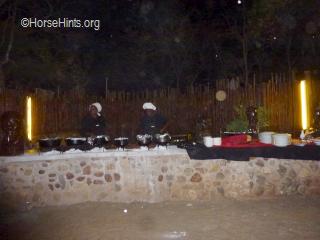
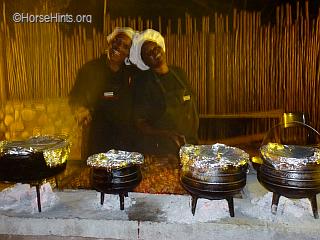
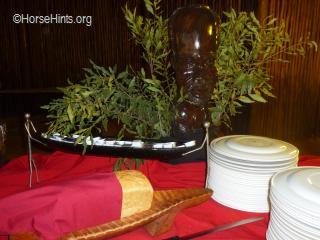
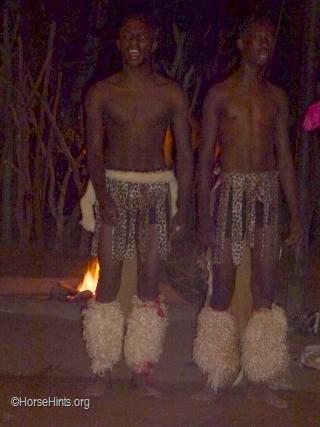
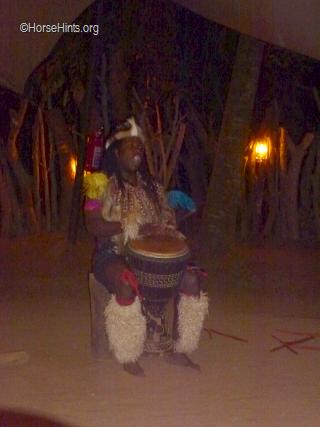
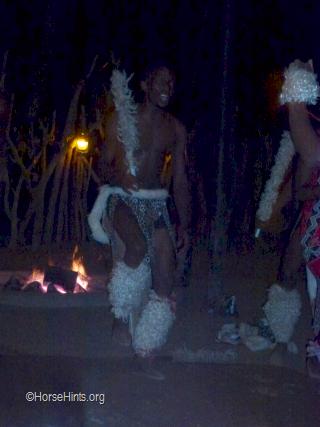
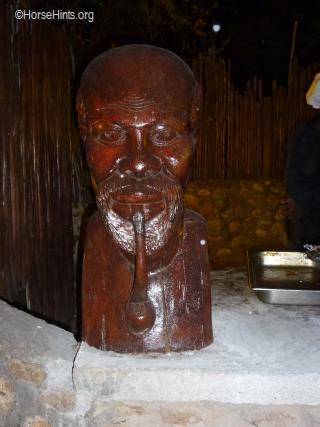
Kudu
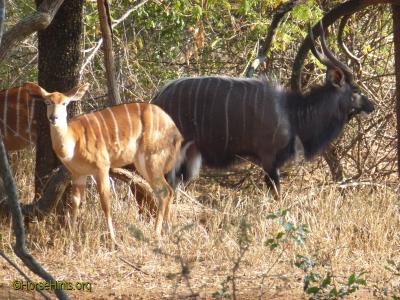
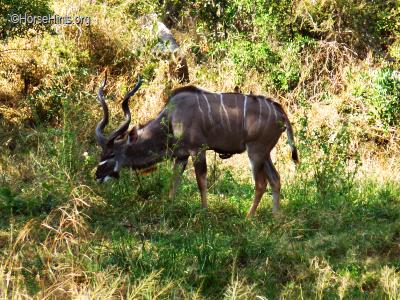
"...The name of the animal was imported into English in the 18th century from isiXhosa iqhude, via Afrikaans koedoe part zebra part deer. Kudu, or koodoo, is the Khoikhoi name for this antelope. Tragos (Greek) denotes a he-goat and elaphos (Greek) a deer. Strepho (Greek) means 'twist', and strephis is 'twisting'. Keras (Greek) refers to the horn of the animal.
Habitat
Lesser kudus come from the savanna near Acacia and Commiphora shrubs. They have to rely on thickets for protection, so they are rarely seen in the open. Their brown and striped pelts help to camouflage them in scrub environments.
Behavior
Like many other antelope, male kudus can be found in bachelor groups, but they are more likely to be solitary. Their dominance displays tend not to last long and are generally fairly peaceful, consisting of one male making himself look big by making his hair stand on end. When males do have a face-off, they will lock their horns in a competition to determine the stronger puller; kudus' necks enlarge during the mating season for this reason. Sometimes two competing males are unable to unlock their horns and, if unable to disengage, will die of starvation or dehydration. Males are seen with females only in the mating season, when they join in groups of 5-15 kudus, including offspring. Calves grow very quickly and at six months are fairly independent of their mothers.
A pregnant female will leave the herd to give birth to a single offspring. She will leave the newborn lying hidden for 4-5 weeks while coming back only to nurse it, which is the longest amount of time for any antelope species. Then the calf will start meeting its mother for short periods. At 3 or 4 months, the calf will be with its mother constantly, and at about six months they will permanently join the group.
When threatened, the kudu will often run away rather than fight. Wounded bulls have been known to charge the attacker, hitting the attacker with their sturdy horn base rather than stabbing it. Wounded females can keep running for many miles without stopping to rest for more than a minute. They are great kickers and are capable of breaking a wild dog's or jackal's neck or back. They are good jumpers and can clear a 5-foot fence from a standing start.
Diet
Kudus are browsers and eat leaves and shoots. In dry seasons they eat wild watermelons and other fruit for their liquid content and the natural sugars that they provide. The lesser kudu is less dependent on water sources than the greater kudu.
Predators and Threats
Predators, such as lions and leopards, African wild dogs, hyenas, and sometimes pythons, hunt kudu and their young. Kudu numbers are also affected by humans hunting them for their meat, hides and horns, or using their habitats for charcoal burning and farming. Kudus were highly susceptible to the rinderpest virus (now eradicated after a vaccination program in domestic cattle), and many scientists think recurring epidemics of the disease reduced kudu populations in East Africa. Kudus are highly susceptible to rabies in times of extended drought. They have been known to enter farm houses and other buildings when infected. Infected animals appear tame and have a distinct frothing at the mouth. They are fearless and bulls may sometimes attack humans who get too close to them.
Meat
Kudu meat is similar to venison (deer), with a slight gamey, liver-like flavor. It is a very dry and lean meat, so it needs to be cooked carefully to avoid drying it out and making it difficult to eat. When prepared correctly, it can be very healthy because of its low fat content...." Please follow the link for the rest of the article: Kudu ![]()
Impala
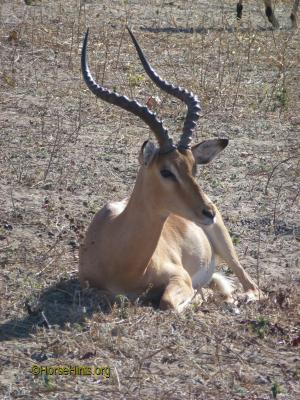
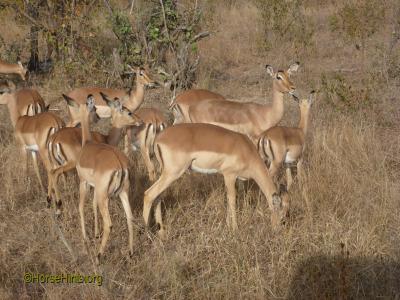
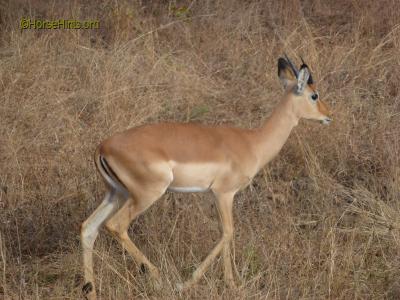
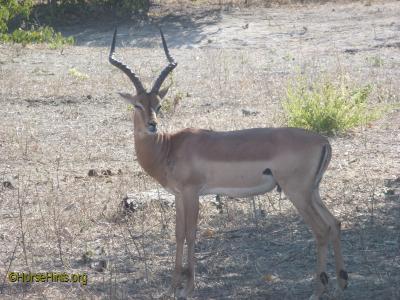 The impala...is a medium-sized antelope found in eastern and southern Africa. The sole member of the genus Aepyceros, it was first described by German zoologist Martin Hinrich Carl Lichtenstein in 1812. Two subspecies are recognised-the common impala, and the larger and darker black-faced impala. The impala reaches 70-92 centimetres (28-36 inches) at the shoulder and weighs 40-76 kg (88-168 lb). It features a glossy, reddish brown coat. The male's slender, lyre-shaped horns are 45-92 centimetres (18-36 inches) long.
The impala...is a medium-sized antelope found in eastern and southern Africa. The sole member of the genus Aepyceros, it was first described by German zoologist Martin Hinrich Carl Lichtenstein in 1812. Two subspecies are recognised-the common impala, and the larger and darker black-faced impala. The impala reaches 70-92 centimetres (28-36 inches) at the shoulder and weighs 40-76 kg (88-168 lb). It features a glossy, reddish brown coat. The male's slender, lyre-shaped horns are 45-92 centimetres (18-36 inches) long.
Active mainly during the day, the impala may be gregarious or territorial depending upon the climate and geography. Three distinct social groups can be observed: the territorial males, bachelor herds and female herds. The impala is known for two characteristic leaps that constitute an anti-predator strategy. Browsers as well as grazers, impala feed on monocots, dicots, forbs, fruits and acacia pods (whenever available). An annual, three-week-long rut takes place toward the end of the wet season, typically in May. Rutting males fight over dominance, and the victorious male courts female in oestrus. Gestation lasts six to seven months, following which a single calf is born and immediately concealed in cover. Calves are suckled for four to six months; young males-forced out of the all-female groups-join bachelor herds, while females may stay back.
The impala occurs in woodlands and sometimes on the interface (ecotone) between woodlands and savannahs; it inhabits places close to water. While the black-faced impala is confined to southwestern Angola and Kaokoland in northwestern Namibia, the common impala is widespread across its range and has been reintroduced in Gabon and southern Africa. The International Union for Conservation of Nature (IUCN) classifies the impala as a species of least concern; the black-faced subspecies has been classified as a vulnerable species, with less than 1,000 individuals remaining in the wild as of 2008...." Please follow the link for the rest of the article: ![]() Impala
Impala ![]()
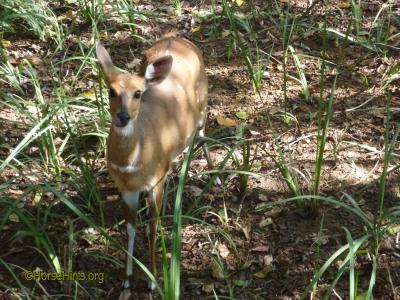 "The imbabala or Cape bushbuck is a widespread species of antelope in Sub-Saharan Africa. Formerly, two species were recognized under the generic name 'bushbuck'; the kéwel (Tragelaphus scriptus) and the imbabala (Tragelaphus sylvaticus). Both species are more closely related to other members of the tragelaphine family than to each other (the imbabala to the bongo and the sitatunga, and the kéwel to the nyala). Imbabala are found in rain forests, montane forests, forest-savanna mosaics, and bush savanna forest and woodland.
"The imbabala or Cape bushbuck is a widespread species of antelope in Sub-Saharan Africa. Formerly, two species were recognized under the generic name 'bushbuck'; the kéwel (Tragelaphus scriptus) and the imbabala (Tragelaphus sylvaticus). Both species are more closely related to other members of the tragelaphine family than to each other (the imbabala to the bongo and the sitatunga, and the kéwel to the nyala). Imbabala are found in rain forests, montane forests, forest-savanna mosaics, and bush savanna forest and woodland.
Distribution
The imbabala occurs from the Cape in South Africa to Angola and Zambia and up the eastern part of Africa to Ethiopia and Somalia. It occurs sympatrically with the kéwel in northern Angola, southern DRC, around the Lake Albert area, southern Sudan and Ethiopia. Some game farmers in southern Africa discovered that the Cape bushbuck may be excluded by the closely related, larger, nyala when they tried to introduce the two species to the same area. However, the two species are found in close proximity in natural antelope communities (e.g., in Gorongosa National Park, Mozambique).
Description
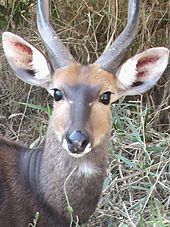
Close-up of an imbabala ram from the Kruger National Park, South Africa
The imbabala is larger than the kéwel and its colouration varies greatly with geography and habitat type. Only the most genetically ancient of the imbabala populations (from Angola, Zambia, southern DRC, Botswana and northern Zimbabwe) bear any significant striping. And even in these populations the horizontal stripe, if present at all, is broken up into a series of spots. Thick horizontal striping as in the kéwel never occurs. In general, patterning in the imbabala reduces with distance away from south-central Africa. Ground colouration is also more variable than in the kéwel, ranging from yellow to red-brown, brown, olive to almost black. Mountain forms of the imbabala in the Gregory Rift Highlands, Mount Elgon, the Imatong Mountains and the Ethiopian Highlands all appear larger, with very dark ground colour and almost no patterning. Much of the variation in ground colouration, especially deviations from red-brown, occurs mainly in males. The first Latin name that can be attributed to the imbabala was Antilope sylvatica after Sparrman (1780) described from the Cape Colony. Its common name, imbabala (Wronski and Moodley, 2009), is taken from the Xhosa language spoken in that part of South Africa. Much of the scientific as well as public interest literature about bushbuck to be found on the internet, pertain only to the imbabala, not the kéwel. As in the rest of the text below.
Imbabala stand about 90 centimetres (35 in) at the shoulder and weigh from 45 to 80 kilograms (99 to 176 lb) (depending on sex). They have a light brown coat, with up to seven white stripes and white splotches on the sides. The white patches are usually geometrically shaped and on the most mobile parts of their body such as the ears, chin, tail, legs and neck. The muzzle is also white and horns are found only on the males and they can reach over half a metre with only one twist. At 10 months old, young males sprout horns that are particularly twisted and at maturity form the first loop of a spiral.
Imbabala mainly browse, but supplement their diet with any other plant matter that they can reach. Imbabala are active around 24 hours a day, but tend to be nocturnal near human habitations. They tend to be solitary, though some live in pairs. Imbabala live within a 'home' area, which is usually around 50,000 square metres on the savannah and much larger in the forest, that they will not normally leave. These areas usually overlap other imbabala home areas. Imbabala are basically solitary animals and the mature males go out of their way to stay away from each other. Usually imbabala are most active during early morning and part of the night, therefore are almost entirely nocturnal in areas where they are unlikely to be disturbed. ..."
Please follow the link for the rest of the article: Bushbuck ![]()
The bushbuck was really yummy! It tasted like venison and was as tender as a good cut of beef. Bill and I had it several times. Try it.
Warthog
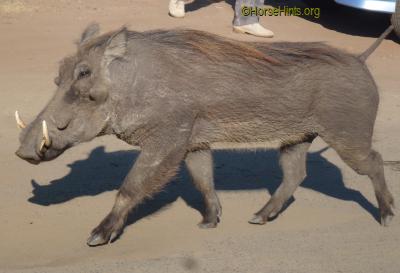 The common warthog is a medium-sized species, with a head-and-body length ranging from 0.9 to 1.5 m (3.0 to 4.9 ft), and shoulder height from 63.5 to 85 cm (25.0 to 33.5 in). Females, at 45 to 75 kg (99 to 165 lb), are typically a bit smaller and lighter in weight than males, at 60 to 150 kg (130 to 330 lb). A warthog is identifiable by the two pairs of tusks protruding from the mouth and curving upwards. The lower pair, which is far shorter than the upper pair, becomes razor-sharp by rubbing against the upper pair every time the mouth is opened and closed. The upper canine teeth can grow to 25.5 cm (10.0 in) long and have a wide elliptical cross section, being about 4.5 cm (1.8 in) deep and 2.5 cm (0.98 in) wide. A tusk will curve 90° or more from the root, and will not lie flat on a table, as it curves somewhat backwards as it grows. The tusks are used for digging, for combat with other hogs, and in defense against predators - the lower set can inflict severe wounds.
The common warthog is a medium-sized species, with a head-and-body length ranging from 0.9 to 1.5 m (3.0 to 4.9 ft), and shoulder height from 63.5 to 85 cm (25.0 to 33.5 in). Females, at 45 to 75 kg (99 to 165 lb), are typically a bit smaller and lighter in weight than males, at 60 to 150 kg (130 to 330 lb). A warthog is identifiable by the two pairs of tusks protruding from the mouth and curving upwards. The lower pair, which is far shorter than the upper pair, becomes razor-sharp by rubbing against the upper pair every time the mouth is opened and closed. The upper canine teeth can grow to 25.5 cm (10.0 in) long and have a wide elliptical cross section, being about 4.5 cm (1.8 in) deep and 2.5 cm (0.98 in) wide. A tusk will curve 90° or more from the root, and will not lie flat on a table, as it curves somewhat backwards as it grows. The tusks are used for digging, for combat with other hogs, and in defense against predators - the lower set can inflict severe wounds.
Common warthog ivory is taken from the constantly growing canine teeth. The tusks, particularly the upper set, work in much the same way as elephant tusks with all designs scaled down. Tusks are carved predominantly for the tourist trade in east and southern Africa.
The head of the common warthog is large, with a mane down the spine to the middle of the back. Sparse hair covers the body. Its color is usually black or brown. Tails are long and end with a tuft of hair. Common warthogs do not have subcutaneous fat and the coat is sparse, making them susceptible to extreme environmental temperatures...."
Please follow this link for the rest of the article: ![]() Common Warthog
Common Warthog ![]()
The warthog may be unpleasant to see, but it is really delicious to eat! Bill and I had it several times. We had it as BBQ spareribs and also as warthog steak. Sometimes it will be referred to as "pumbaa". It tasted like a mixture between beef and pork. It was so juicy, tender and delicious.
Zebra
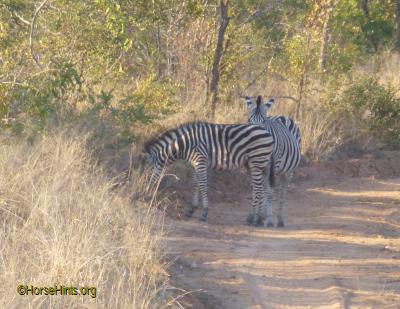 There are different kinds of zebra although they all live in Africa. Each species of zebra has its own home area. Plains zebras live in the treeless grasslands and woodlands of eastern and southern Africa. The Grevy's zebra lives in in the arid grasslands of Ethiopia and northern Kenya. The mountain zebra is found in South Africa, Namibia and Angola.
There are different kinds of zebra although they all live in Africa. Each species of zebra has its own home area. Plains zebras live in the treeless grasslands and woodlands of eastern and southern Africa. The Grevy's zebra lives in in the arid grasslands of Ethiopia and northern Kenya. The mountain zebra is found in South Africa, Namibia and Angola.
"Zebras are several species of African equids (horse family) united by their distinctive black and white striped coats. Their stripes come in different patterns, unique to each individual. They are generally social animals that live in small harems to large herds. Unlike their closest relatives, horses and donkeys, zebras have never been truly domesticated.
There are three species of zebras: the plains zebra, the mountain zebra and the Grévy's zebra. The plains zebra and the mountain zebra belong to the subgenus Hippotigris, but Grévy's zebra is the sole species of subgenus Dolichohippus. The latter resembles an ass, to which it is closely related, while the former two are more horse-like. All three belong to the genus Equus, along with other living equids.
The unique stripes of zebras make them one of the animals most familiar to people. They occur in a variety of habitats, such as grasslands, savannas, woodlands, thorny scrublands, mountains, and coastal hills. However, various anthropogenic factors have had a severe impact on zebra populations, in particular hunting for skins and habitat destruction. Grévy's zebra and the mountain zebra are endangered. While plains zebras are much more plentiful, one subspecies, the quagga, became extinct in the late 19th century - though there is currently a plan, called the Quagga Project, that aims to breed zebras that are phenotypically similar to the quagga in a process called breeding back...." For the entire article follow the link: Zebra ![]()
I was surprised that the zebra was really tasty. It was pounded and prepared much like a veal cutlet. In fact, it tasted like a veal cutlet. It was quite good. I would eat it again.
Crocodile
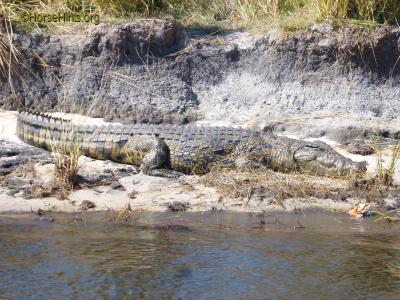
What are the differences between an allligator and a crocodile? "Shape of the jaw: The easiest way of telling apart crocodiles from alligators, however, is to look at their noses. Alligators (and caimans) have a wide 'U'-shaped, rounded snout (like a shovel), whereas crocodiles tend to have longer and more pointed 'V'-shaped noses."
Crocodilian Biology Database ![]()
..."The four species of crocodile found in Africa are:
- Slender-snouted crocodile (Mecistops cataphractus)
- Nile crocodile (Crocodylus niloticus)
- West African crocodile (Crocodylus suchus)
- Dwarf crocodile (Osteolaemus tetraspis)
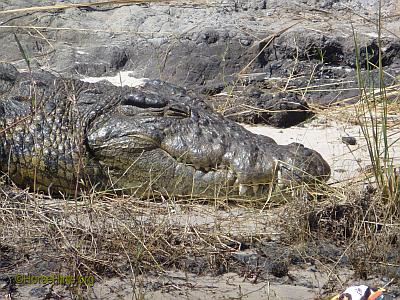 Scientists used to think that there were only three types of crocodile found in Africa: the slender-snouted crocodile, Nile crocodile, and Dwarf crocodile. Recent studies found that there were two types of Nile crocodile, and that they were sufficiently different to one another to be considered separate species. The smaller species is now known as the West African crocodile. It doesn't end there. Other studies have found there to be three species of dwarf crocodile, and possibly two species of slender-snouted crocodile. This means that there may be as many as seven species of crocodile found in Africa! Please follow the link for the rest of the article: Crocodiles in Africa
Scientists used to think that there were only three types of crocodile found in Africa: the slender-snouted crocodile, Nile crocodile, and Dwarf crocodile. Recent studies found that there were two types of Nile crocodile, and that they were sufficiently different to one another to be considered separate species. The smaller species is now known as the West African crocodile. It doesn't end there. Other studies have found there to be three species of dwarf crocodile, and possibly two species of slender-snouted crocodile. This means that there may be as many as seven species of crocodile found in Africa! Please follow the link for the rest of the article: Crocodiles in Africa ![]()
I am glad we tried the crocodile. Again we had it several times in South Africa and Zimbabwe. It is not thrilling but more like an adventure. It is sort of like eating chewy chicken and takes on the flavor of how it is cooked.
Ostrich
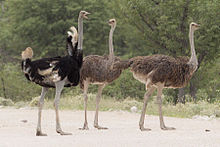 "...The ostrich or common ostrich (Struthio camelus) is either one or two species of large flightless birds native to Africa, the only living member(s) of the genus Struthio, which is in the ratite family. In 2014, the Somali ostrich (Struthio molybdophanes) was recognized as a distinct species.
"...The ostrich or common ostrich (Struthio camelus) is either one or two species of large flightless birds native to Africa, the only living member(s) of the genus Struthio, which is in the ratite family. In 2014, the Somali ostrich (Struthio molybdophanes) was recognized as a distinct species.
The common ostrich shares the order Struthioniformes with the kiwis, emus, rheas, and cassowaries. However, phylogenetic studies have shown that it is the sister group to all other members of Palaeognathae and thus the flighted tinamous are the sister group to the extinct moa. It is distinctive in its appearance, with a long neck and legs, and can run at up to about 70 km/h (19 m/s; 43 mph), the fastest land speed of any bird. The common ostrich is the largest living species of bird and lays the largest eggs of any living bird (extinct elephant birds of Madagascar and the giant moa of New Zealand laid larger eggs).
The common ostrich's diet consists mainly of plant matter, though it also eats invertebrates. It lives in nomadic groups of 5 to 50 birds. When threatened, the ostrich willeither hide itself by lying flat against the ground, or run away. If cornered, it can attack with a kick of its powerful legs. Mating patterns differ by geographical region, but territorial males fight for a harem of two to seven females. The common ostrich is farmed around the world, particularly for its feathers, which are decorative and are also used as feather dusters. Its skin is used for leather products and its meat is marketed commercially, with its leanness a common marketing point Please follow the link for the rest of the article: ![]() Common Ostrich
Common Ostrich
We have ostrich in Australia and the United States. We tried it again in both South Africa and Zimbabwe. If done on the grill it is a bit chewy. If done in a sauce it is pleasant enough.
Gonimbrasia Belina aka Madora, Mopane Worm
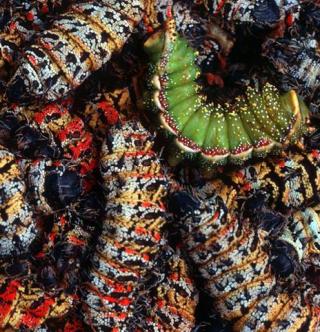
African Mopane Worms
Gonimbrasia belina is a species of emperor moth which is native to the warmer parts of southern Africa. Its large edible caterpillar, known as the Madora, feeds primarily but not exclusively on mopane tree leaves. Mopane worms are an important source of protein for millions in the region....
...Eating
Dried mopane worms can be eaten raw as a crisp snack; however, in Botswana people tend not to eat the head. Alternatively, mopane worms can be soaked to rehydrate, before being fried until they are crunchy, or cooked with onion, tomatoes and spices and then served with pap or sadza. The flesh is yellow, and the gut may still contain fragments of dried leaf, which is not harmful to humans. The taste of dried leaves, if not removed, is somewhat reminiscent of tea leaves. Dried mopane worms are frequently canned/packaged in tomato sauce or chili sauce to enhance the flavor.
In November 2015, a Cornell team of food scientists placed third in Brisbane, Australia at the 2015 Global Business Challenge, by presenting the economic and nutritional benefits of transforming proteins from mopane worms into food.
Farming and Economics
The harvesting and sale of mopane worms is a multi-million rand industry in Southern Africa. The principal producers are Botswana, Namibia, South Africa (Limpopo Province and Mpumalanga) and Zimbabwe. Typically, the caterpillars are not domesticated, and are picked wherever they occur naturally. It is one of the region's most economically important insects. In the 1990s, hundreds of tons were exported from Botswana and South Africa each year. It is estimated that South Africa alone trades 1.6 million kilogrammes of mopane worm annually, and that Botswana's involvement in this industry nets it roughly $8 million annually.
Mopane worms are considered to be a profitable harvest, as a mere three kilograms of feed (mopane leaves) will generally yield one kilogram of mopane worms: in contrast, cattle farming requires ten kilograms of feed to generate one kilogram of beef; thus the worms are a low-cost, low-maintenance, high-protein food source.
...Harvested Mopane Worms
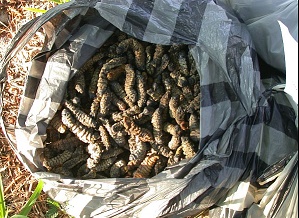 Traditionally, mopane worms were harvested for subsistence. Because of the seasonal nature of the occurrence of these edible caterpillars, they are not a year-round food source. However, traditional mopane worm harvesting is evolving to be more commercially-driven. Since the 1950s, commercial farming methods have been applied to the mopane worm harvests, particularly in South Africa. Collectors may organise teams of hundreds of people to hand-pick the caterpillars from the trees, after which they are bagged en masse, weighed, and sent off to be processed. Owners of land where mopane worms are found may charge harvesters large fees to enter. Whereas this relationship profits both the commercial harvester and the farmer, it is often to the detriment of the local community for whom the caterpillars may previously have been an important source of food and seasonal income..." To read the rest of the article please follow the link: Gonimbrasia Belina
Traditionally, mopane worms were harvested for subsistence. Because of the seasonal nature of the occurrence of these edible caterpillars, they are not a year-round food source. However, traditional mopane worm harvesting is evolving to be more commercially-driven. Since the 1950s, commercial farming methods have been applied to the mopane worm harvests, particularly in South Africa. Collectors may organise teams of hundreds of people to hand-pick the caterpillars from the trees, after which they are bagged en masse, weighed, and sent off to be processed. Owners of land where mopane worms are found may charge harvesters large fees to enter. Whereas this relationship profits both the commercial harvester and the farmer, it is often to the detriment of the local community for whom the caterpillars may previously have been an important source of food and seasonal income..." To read the rest of the article please follow the link: Gonimbrasia Belina ![]()
African recipe: Mopane worms (Madora)
Madora is a traditional Zimbabwean delicacy that is enjoyed by those who have acquired the taste! This delicacy is mostly cooked in the rural areas, and is a dish that a Zimbabwean grandmother would make for you. But you are encouraged to try this simple recipe at home. We had Mopane Worms at a Boma Dinner in Limpopo Province. They were cooked on the grill and tasted like crunchy, grilled saw dust. It was not my favorite taste but I did swallow one worm. No seconds for me!
Mopane worms known as delicacies in some African states
Mopane worms known as delicacies in some African states
Zambizi River Bream
Bill and I really enjoyed this particular fish. We had never eaten it. The chef prepared it for us at our Safari Lodge (Victoria Safari Lodge) in Zimbabwe. It was a mild fish with the texture of cod. If I could get it in the Washington, DC I would definitely buy it and prepare it. If you go to Zimbabwe definitely give it a try.
Bream from Zambezi River
Bream from Zambezi River
